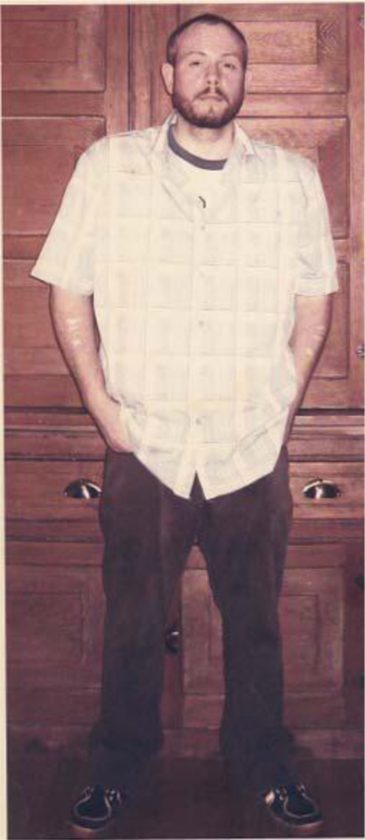Missing-person mystery solved: DNA connects Lawrence man, missing since 2015, to body found in Missouri

photo by: Mackenzie Clark/Journal-World Photo Illustration; Journal-World file photo; Contributed photo
This Journal-World photo illustration shows Phillip Owen Morgan, who was last seen on June 5, 2015. In the background is a Journal-World file photo that shows the high water of the Kansas River at Lawrence the following day, June 6, 2015. The information to the side is from a missing persons poster issued when Morgan first went missing.
From the time he was assigned the case until even after he retired, former Lawrence Police Detective Warren Burket never stopped wondering what happened to Phillip Owen Morgan.
Morgan was 38 years old when he was reported missing June 11, 2015. Burket didn’t get the case until about a month later. Reflecting about 4 1/2 years later, Burket said that the “first 48” — hours after someone goes missing, that is — really are the most important to finding that person.
Burket was at a disadvantage from the beginning, but that didn’t stop him from pouring hours into the search until he retired in March 2018. He said he made sure to leave a thorough case file in the hopes that another detective would keep Morgan in mind.

photo by: Contributed Photo
Phillip Owen Morgan went missing in June 2015.
Burket and the rest of the Lawrence Police Department didn’t find out until late last month that Morgan’s body was found just three days after he disappeared. DNA technology helped investigators discover the match.
The search
The Journal-World reported on Morgan’s disappearance just once, a search of the archives shows. In a July 2, 2015, article, the newspaper reported that Morgan had last been seen on June 5 of that year at his home in the Tamarind Apartment Complex at 1517 W. Ninth St. Police were asking for the public’s help to find him.
Burket said he and another officer, who is now Sgt. David Ernst, started to investigate the case when they got it: they talked to Morgan’s parents and people who were part of the mental health community who they knew were concerned about Morgan. They visited trails and kitchens and spoke with many people, some of them multiple times.
They had some concerns because Morgan had a history of mental illness. There was the potential that he had died by suicide, Burket said. He could have died by accident, too.

photo by: Journal-World File Photo
Since-retired Lawrence Police Detective Warren Burket is pictured in this Journal-World file photo from Dec. 19, 2014.
Many of Morgan’s friends and people who said they’d seen him around also had some mental health issues, Burket suspected, and he thinks some of them had exaggerated a bit or might have seen Morgan but the time period was “way off,” he said.
There were a lot of directions the case could have gone. One common refrain Burket said he heard in interviews was that Morgan liked to hike near the Kansas River.
“I started walking trails, and doing a lot of different follow-up to try and locate him,” Burket said. “And eventually what ended up happening was I kind of ran out of leads, but I did everything you could possibly think of.”
If someone had been camping near Burcham Park and the river rose rapidly, Burket said, he could have been sucked into the river and pushed far downstream.
Every once in a while, Burket said, he’d get a new lead that would send him in a different direction. Each time he returned to that apartment complex for a call, he’d show Morgan’s photo and ask people if they knew him or where he might be. Over the years the leads were fewer and fewer, though, Burket said.
“I walked so many different places and talked to so many different people that, you know, in the end, I was holding out that possibly he had survived somehow, or he was with somebody or he would turn up,” he said. “But that never did happen, unfortunately.”
Burket said it hasn’t exactly kept him awake at night, but certain things will “kick a memory up” and he’ll start thinking and wondering about certain cases. Sometimes sensory details will create the spark. For Burket, Morgan’s was definitely one of those cases.
“I will say toward the end of my career, it was one of those things where you really wanted it to be a positive outcome rather than a negative one for sure,” said the detective who spent all of his 27 years in law enforcement with LPD. “So I kept trying to run out any leads that might come up.”
What happened?
It seems the hypothesis that Morgan was lost in the Kansas River was accurate. It was one Burket had investigated, but he was simultaneously hearing from people he interviewed that they’d seen Morgan recently.
“I was still going off of the assumption that he was still alive,” Burket said.
On June 14, 2015, three days after Morgan was reported missing, an unidentified man was found near Hartsburg, Mo. The town is about 10 miles northeast of Jefferson City along the Missouri River.
The body was roughly 240 river miles away from Burcham Park, according to LPD spokesman Patrick Compton.
Burket said that at the time, the river level was 6 to 8 feet above the banks, and the water was moving fast. He’d asked folks at Bowersock Dam, and he said they told him someone could have been sucked into the river and pushed far enough downstream to end up in the Missouri River, or even the Mississippi River.
If you follow the Kansas River east and north through Kansas City, it meets the Missouri River near the state line; the Missouri River then continues east until it turns southward about halfway through the state, west to east. After that turn, it heads toward Jefferson City before turning back to the east and meeting the Mississippi in St. Louis.
The “John Doe” who was found had died by drowning, Compton said. That did not come as a surprise to Burket.
He always hoped to go back to Morgan’s parents with good news, but “in the long run, it is closure after such a long period of time,” Burket said. “… I’m very glad that they do have closure.”
Compton said Morgan’s family did not want to speak with the newspaper for this article.

photo by: Journal-World File Photo
This Journal-World file photo shows high water in the Kansas River at Lawrence one day after Phillip Morgan was last seen on June 5, 2015.
NamUs: Other cases
The National Institute of Justice began funding major efforts to use DNA technology in criminal justice, including in missing and unidentified persons cases, in 2003. The National Missing and Unidentified Persons System, or NamUs, was created to improve access to information that would help with that goal, according to the program’s website, namus.gov.
NamUs documents comparisons of DNA from family members of the missing with that of unidentified persons. The comparisons are facilitated through the FBI’s Combined DNA Index System, or CODIS, according to J. Todd Matthews, director of communications and outreach for NamUs.
Shortly after Morgan was matched to the “John Doe” in Missouri, both cases disappeared from the NamUs website. However, a few cases from this area remain unsolved and listed.
Another case that has made Journal-World headlines over the years is the April 16, 1988, disappearance of Randy Leach, of Linwood. Leach went missing after a classmate’s graduation party in Leavenworth County. He was 17 years old.
According to NamUs, 14 unidentified persons have been excluded from possibly being Leach — 12 in Virginia and one each in Nevada and New York.
Another long-missing Lawrence man is Elvin Everett Crist, who disappeared Dec. 10, 1996, at age 40. His family had him declared dead about a decade after he vanished, the Journal-World has reported.
NamUs’s website says two comparisons, one in Virginia and one in Minnesota, have both excluded Crist.
NamUs currently lists 26 unidentified persons found in Kansas, none in Douglas County. It lists 89 missing from Kansas, including Crist and Leach.
Contact Mackenzie Clark
Have a story idea, news or information to share? Contact public safety reporter Mackenzie Clark:





